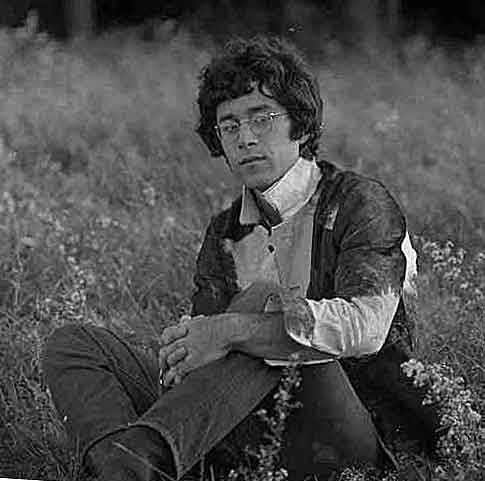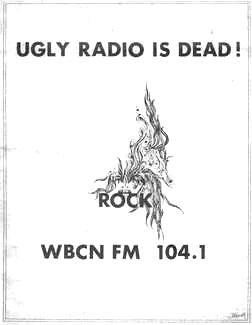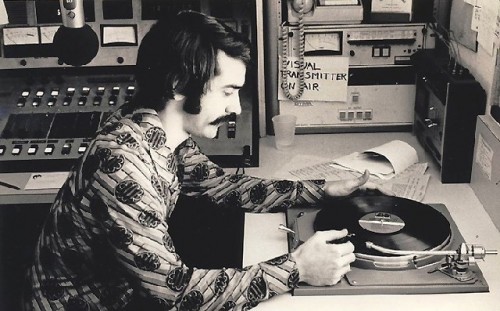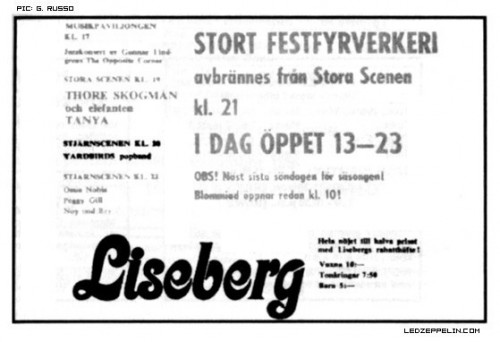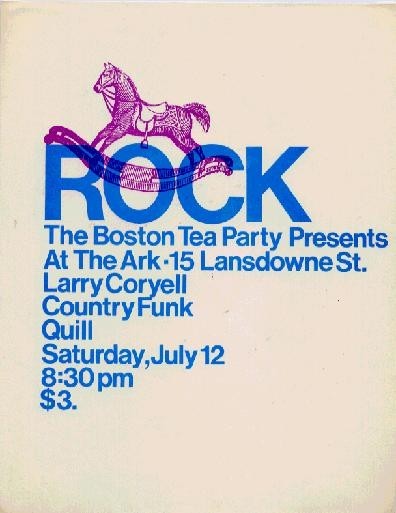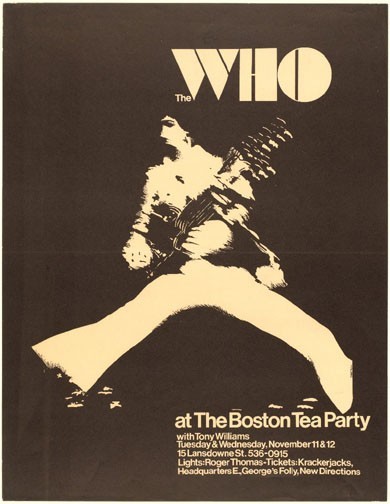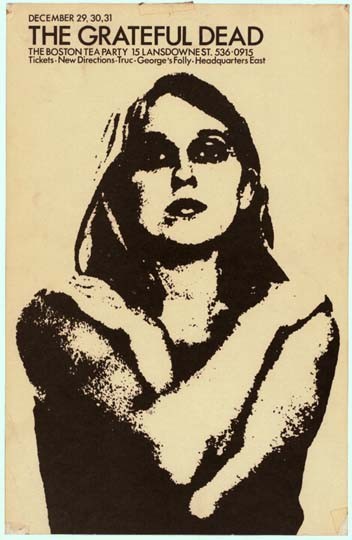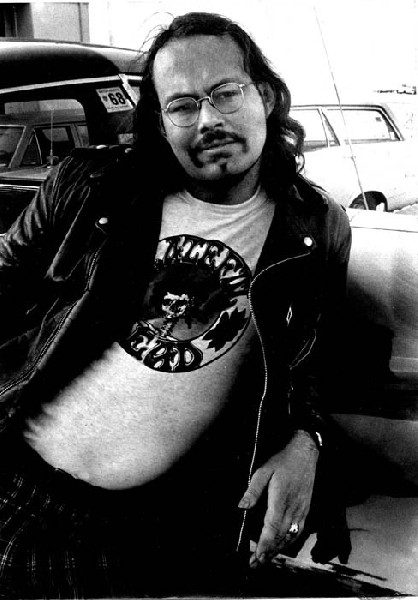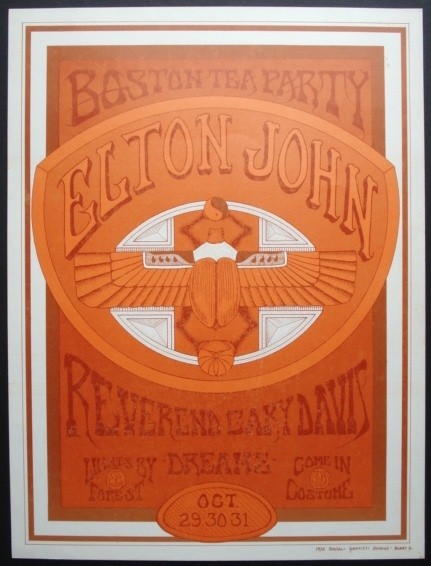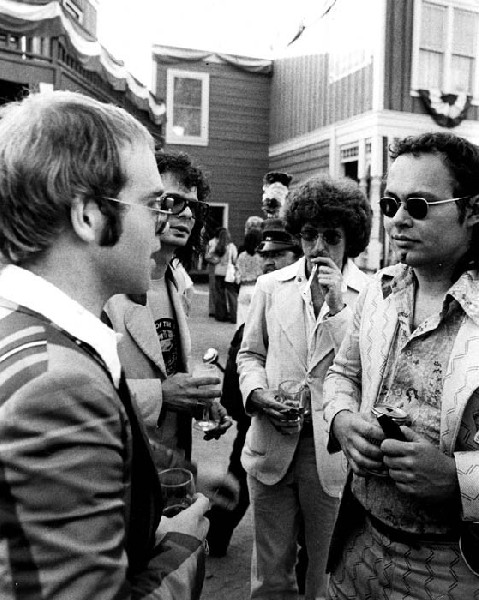Steve Nelson, WBCN, Part Four
Hello Freeform Radio, Bye-Bye Boston Tea Party
By: Steve Nelson and Charles Giuliano - Apr 18, 2011
Charles Giuliano: We’ve been talking about the music scene in Boston in the late 1960’s, and in particular The Boston Tea Party rock and blues club, which you managed in 1967-68. You were saying in our last conversation that Ray Riepen, the lawyer from Kansas City who started and owned the club, was looking for ways to build on its success. It was presenting more out-of-town acts, not just the local bands it began with, and had really become the place to go in Boston.
Steve Nelson: I came on board as general manager of the Tea Party in August 1967, and once I got my feet under me, I was pretty much running things, from booking the bands to promoting the shows to taking care of business during the day to personally taking the receipts to the bank deposit box at the end of the night. It was all cash, which we never skimmed if you’re wondering, and no, I never got held up. That freed up Ray to look for new opportunities, and he saw that the kind of music being played at the Tea Party and being sold on millions of stereo LPs was, except for hit singles from those albums, not heard on commercial radio stations, which were only mono AM anyway.
But there was a new kind of programming you could hear on some of the college stations in the Boston area, what came to be called freeform radio. The DJs didn’t work from a fixed playlist of Top Forty singles, but played whatever they were into, cuts from LPs which never made it onto the AM air. They really had to be knowledgeable about music to make it work. The most well-known of those jocks at the time, with great taste in music and a hip on-air personality to match, was Tom “Uncle T” Gamache on the MIT radio station WTBS. Incidentally, a few years later the station needed money for a new transmitter and sold those call letters for $50,000 to Ted Turner, who wanted them for the cable TV business he was launching.
CG: In 1968 Ray persuaded T. Mitchell Hastings to put freeform rock programming on the FM station he owned in Boston, WBCN. How did that come about?
SN: In April 1967 the legendary San Francisco DJ Tom Donahue first brought the freeform album-oriented format to a commercial station, KMPX. My brother Peter was in college out there at the time, and not long after I went to work at the Tea Party, he sent me two hours of reel-to-reel tape recordings he made of Donahue’s show, figuring I’d dig them. He was right, I did. And after listening to them I gave them to Ray, because I knew he was looking into doing something with radio.
That was one more piece of the puzzle which fell in place for him, hearing a commercial station go freeform. By early 1968 he was deep into negotiations with T. Mitchell Hastings to air rock programming on BCN. Hastings was one of the pioneers of stereo FM. He invented the FM car radio, and built a chain of classical music stations – WBCN, the Boston Concert Network, WXCN in Providence, WHCN in Hartford, WNCN in New York.
CG: Ron Della Chiesa, a music host on WGBH-FM for decades, worked for Hastings at the time in his first radio job. He told me that the station program director had three bins to select from: "fast" "medium" and "slow." I interviewed Hastings at one point and to say that he was eccentric risks understatement.
SN: His parents were followers of the psychic Edgar Cayce, who on at least one occasion conducted a reading for them in their apartment on Park Avenue in New York. But that didn’t help their son foresee that by 1968 his stations would be bankrupt, and that WBCN would replace classical music with easy listening and literally beg on-air for sponsors to buy spots. Hastings was not comfortable with rock and the counterculture, but he was desperate, so he cut a deal with Ray to let him program the graveyard shift from 10:30 pm to 5:30 am.
In keeping with the Boston Tea Party name, I came up with “The American Revolution” as the brand for the new programming on BCN, which went live on March 15, 1968. Me and a couple of the jocks dreamed up a promotion stunt for the launch. At 10:30 the few listeners of the station would hear what seemed to be a gang of hippies bursting into BCN’s studio, “liberating it” in Sixties parlance, and playing rock, starting with Cream’s “I Feel Free.” No doubt some listener hearing that would have called the cops, and the next thing you know Newbury Street would be cordoned off and bullhorns would be demanding that people surrender peacefully.
It would have been the biggest media event since Orson Welles aired “War of the Worlds,” and everyone would know about BCN and its new format. But it never happened. Ray was worried that the “takeover” stunt would cause Hastings to back out of the deal, so at 10:30 all you heard was “I Feel Free.” As it turned out, that was all we needed, to let the music be the promo. News about the new format went crazy viral by word-of-mouth. By May 1st rock had taken over BCN 24 hours a day, and you could walk around Boston or Cambridge neighborhoods where lots of young people lived, and hear the station blasting out of open windows. Music to Ray’s ears, no doubt.
CG: I remember Ray back then, always wearing a suit and tie and often smoking a cigarette. He had this impish little smile, like “I know something and you don’t.” But with the huge overnight success of WBCN, he must have been grinning from ear to ear. And speaking of overnight, Peter Wolf, later of J. Geils Band fame, DJ’ed a late-night show on BCN.
SN: Yeah, when BCN first went rock, Peter was on the air from 2:00 am to 5:30, the “Woofa Goofa” doing the jive patter he became famous for and spinning R&B tunes for “the little ladies of the night.” He was still with his first band, The Hallucinations, who were practically the Tea Party house band. In fact, in the very early days of rock on WBCN, the 10:30 to 2:00 shift originated remotely from what we called “the back room” at the Tea Party, which was a combination dressing room and hangout. Hastings was nervous about people seeing longhairs going into the building on Newbury Street where BCN’s studios were. So a portable two-turntable board was installed at the Tea Party, along with what was the record library at the time, a few cartons of LPs.
I guess T. Mitchell was OK with Wolf doing his shift at the studio in the wee hours when no one was around. What that meant was that before Wolf’s shift we’d leave a few LPs with the jock on air, throw the rest into the Tea Party’s VW bus, and someone would drive them the few blocks to Newbury, take the elevator to the third floor and then carry them up two flights of stairs to the fifth-floor studio for Wolf’s show. Obviously, that arrangement didn’t last long. The record library grew enormously as the labels sent BCN everything they issued in hopes of getting airplay. They were also, as expected, among the first advertisers. When ad dollars started pouring in, Hastings quickly got over his hangup about having hippies hanging at Newbury.
CG: With all that going on, though, you left the Tea Party that summer. Why?
SN: When I got hired by Ray in the summer of ’67, we had a one-year deal paying me $1,000 a month, plus use of the club’s VW bus. For a neophyte in the club business, it wasn’t bad money at the time, and as a music fan, put me in the center of the hottest spot in town. When I came on board the Tea Party was still pretty much just a local club, but a year later it had become internationally famous. That was not all my doing by any means, we were riding this huge cultural wave, but I knew how to ride it. Plus, WBCN had taken off. So I told Ray I wanted more money and a piece of the action, but he wasn’t buying.
Then one day my friend Kenny Greenblatt, who left his job as a teacher in the suburbs and would later become a mainstay of the BCN sales department, said to me, in his unique baritone voice, “Hey Stevie, let’s go hitchhike around Europe.” Well, I never intended to have a career in club management, and Ray was giving me grief, not only about the new deal I wanted, but also about my bookings. He was particularly annoyed that I booked The Jeff Beck Group for four nights in late June for the total princely sum of $2,000. Jeff, Rod Stewart, Ron Wood. They packed the place, and Ray made a bundle. That was the last straw for me, so in the hippie spirit of the times, I just said sayonara and a couple of weeks later flew to London with Kenny.
They were having record rains there, you couldn’t walk anywhere without getting soaked. So we spent a lot of time in pubs, and my Tea Party connection got us into the “in” clubs. At one I met a well-known folk-rock singer who took me home with her, a fair port in a storm. But the rain was just too much to take, so Kenny and I got on a ferry to Germany, where it was sunny. When we started hitchhiking from the ferry terminal, people yelled at us from their cars, and even tried to run us off the road. Long hair was definitely not the thing in Germany in 1968.
We got out of there the next day on a ferry to Sweden. On board we met this Swedish rock band returning from a recording session in New York with Tom Wilson. What a small world! Tom lived in Cambridge, was a friend of Kenny, and as I mentioned in our last conversation, had produced The Velvet Underground, Bob Dylan, Simon & Garfunkle and the Boston band The Bagatelle, as well as some major jazz artists. So these four Swedish kids, and I’ve forgotten the name of their band, which never went anywhere, were thrilled to meet us and invited us to stay with them in Gothenburg.
One night we went to an afterhours club and who did we run into there but Jimmy Page. I had just booked him at the Tea Party in April for what turned out to be the Yardbirds last American tour. So it was “Hey man! What’s happening? What are you doing in Sweden?” He was playing a few dates in Denmark and Sweden with his new band, then called the New Yardbirds, before debuting it in London, and introduced me and Kenny us to his new lead singer, a guy with a big mop of curly blond hair named Robert. We had just missed one of the first-ever performances of the band which was soon renamed Led Zeppelin.
Sweden starts to get cold in September, so we went to Mallorca and Ibiza for several weeks before going home. Within a couple of days of returning to Cambridge I was approached by some people who were starting a new club, The Ark, which they were building in an old taxi garage on Lansdowne Street, behind Fenway Park. It was going to have a much bigger and nicer space than the Tea Party, and I agreed to become the booking manager. It opened with a big promotional splash and klieg lights on New Years Eve 1968. Spirit, a hot new band from California, headlined, with Tea Party regulars The Beacon Street Union opening.
The club was the baby of Charlie Thibeau, a businessman from the ‘burbs who wanted to be cool, which to him included driving an Excalibur, an expensive and showy replica of a 1930s Mercedes roadster with a Corvette engine. He poured a lot of money into The Ark, especially into multimedia effects, but knew nothing about music. He thought people would come to the club for the trippy environment, and that the music was secondary. So it wasn’t long before he started complaining about my bookings and the money we were paying the bands. I didn’t need that again, so I bailed and told my music business contacts that Charlie didn’t know what he was doing, and that the only real game in town was still the Tea Party.
CG: When The Ark opened I was the design director for Boston After Dark. I created the half page ad and illustration for the opening. I well remember the event and hung out there after that. John Kostik of Omniversal Design created a metal pod over the space that was supposed to be the control booth. But it didn’t prove to be functional. There were groovy ramps and curved walls but they didn’t put in a wooden dance floor. So it really didn’t work as a dance floor. There was a gallery near the entrance that became a more or less permanent exhibition of the visionary paintings of Paul Laffoley. Today he is regarded as one of the most important Boston artists of his generation.
SN: Ray Riepen and Don Law, who took over as manager of the Tea Party when I left there, had been looking for a larger venue so they could bring in bigger acts and bigger crowds. By July the Ark sank and the Tea Party moved into its space at 15 Lansdowne Street, where it remained until it closed down in late 1970. If you look back at the bookings of who played at the Lansdowne venue – yes, The Who played there -- it was an astonishing array of performers who went on to become famous, infamous and even legendary. But by the time the Tea Party was shuttered, band performance fees had escalated to the point that the club could no longer afford to book the bands it helped put on the map of rock ‘n’ roll.
CG: I became a regular when Don took over the Tea Party on Lansdowne Street. I interviewed him for a story in Boston After Dark. It proved to be his first personal coverage. So that kind of created a relationship with him and resulted in full access to the club. There was a side entrance and Don had his office next to it. There was a guy at the door. Don would check you out. From there was a staircase to the green room on the second floor. You could just walk in and hang out with bands like the Allman Brothers, Grateful Dead, Fleetwood Mac. There was a men’s room where you could sneak a joint. Rock critic Tim Crouse and I were taking a toke when Joe Cocker barged in and asked for a toke. Later on stage he sang “I Get High with a Little Help From My Friends.” He mentioned us. There was the famous New Year’s Eve gig with the Dead when they served spiked acid punch. Jerry Garcia was a hoot to hang out with.
SN: The Dead did a New Year’s gig every year in San Francisco, except for that one Tea Party show on December 31, 1969. So that says a lot about the club’s stature in the rock world then.
CG: There were a couple of times when the Green Room was off limits. There was no access during a gig by The Who. Another occasion was the Delaney and Bonnie tour with Eric Clapton in February 1970. Fleetwood Mac was on the bill. There was a long delay during which there was a jam session with Peter Green of Mac, Clapton, and Joe Walsh of the James Brothers. When Delaney and Bonnie finally performed they were sloppy and smacked up.
Later that year I got a call from an L.A. PR firm to go talk to this new British star who was having his first East Coast gig at the Tea Party over the Halloween weekend. I knocked on his door at a motel near Fenway Park. This guy answered the door soaking wet holding a towel around his waist. It was Elton John. There were maybe a hundred people at the club opening night. I wrote his first US review and interview. Whenever he was in town Elton phoned me and invited me backstage. He flew me out to LA when Rocket Records was launched with a party at Universal Studios.
SN: That Elton John gig on Halloween weekend was one of the last shows at the Tea Party, which closed a few weeks later. Truly the end of an era.
CG: By the end of the Tea Party I had joined the Boston Herald Traveler as the rock and jazz critic. Promoting rock acts had progressed from clubs to arenas. After that access to bands got a lot tougher.
SN: It got a lot tougher for audiences, too. No more $3 or $4 shows. No place to hang out. The Boston Tea Party was the center of gravity for the music scene in Boston from 1967 to 1970, for both fans and musicians. When it shut down, everyone spun off into their own orbit.
Links:
WBCN aircheck tapes (hear Peter Wolf in 1968, Steven Segal in 1969, and Charles Laquidara in 1970 and 1971)
Documentary on WBCN (in production)
Listen to Freeform BCN online (produced by Sam Kopper)

